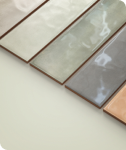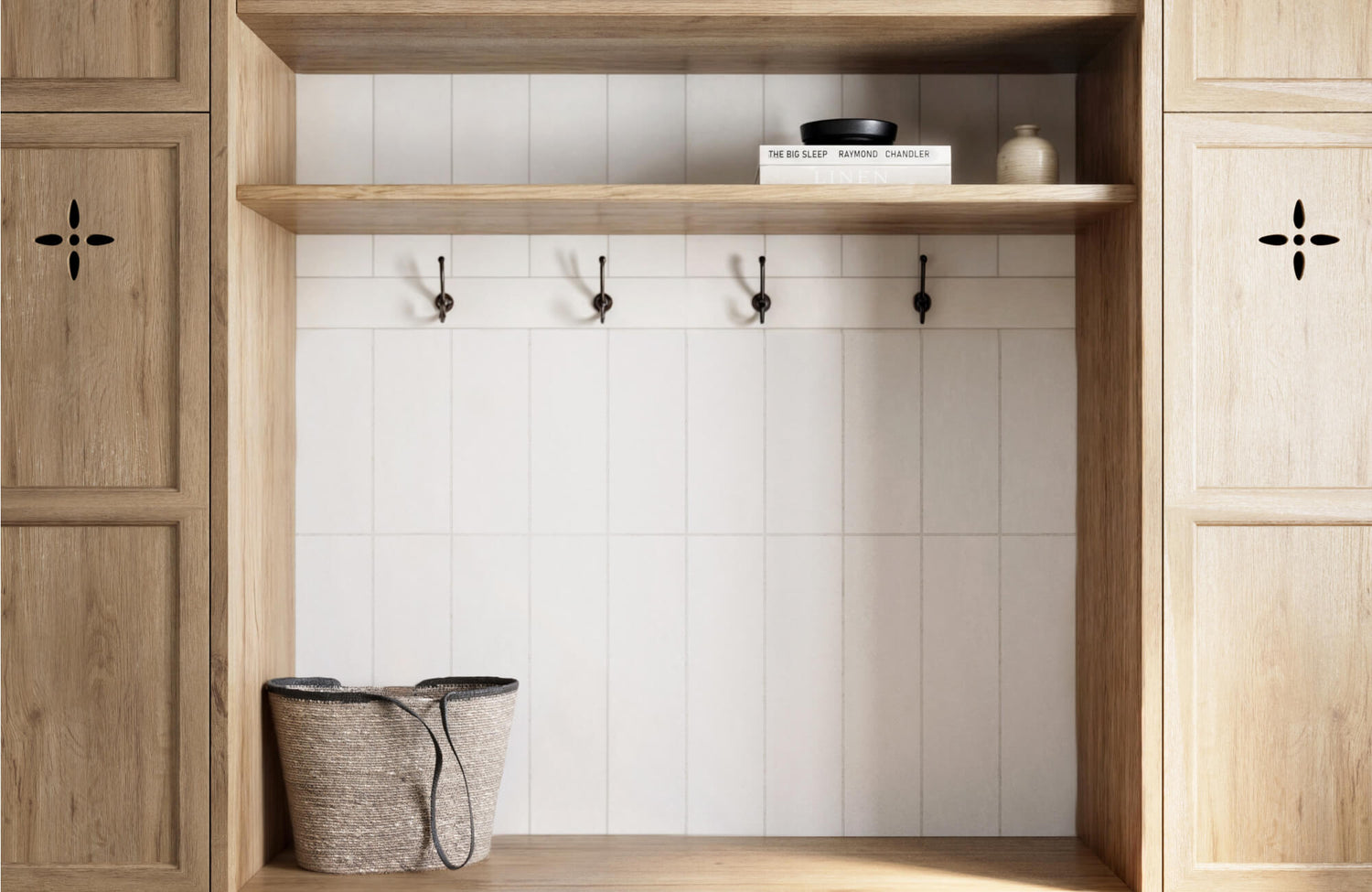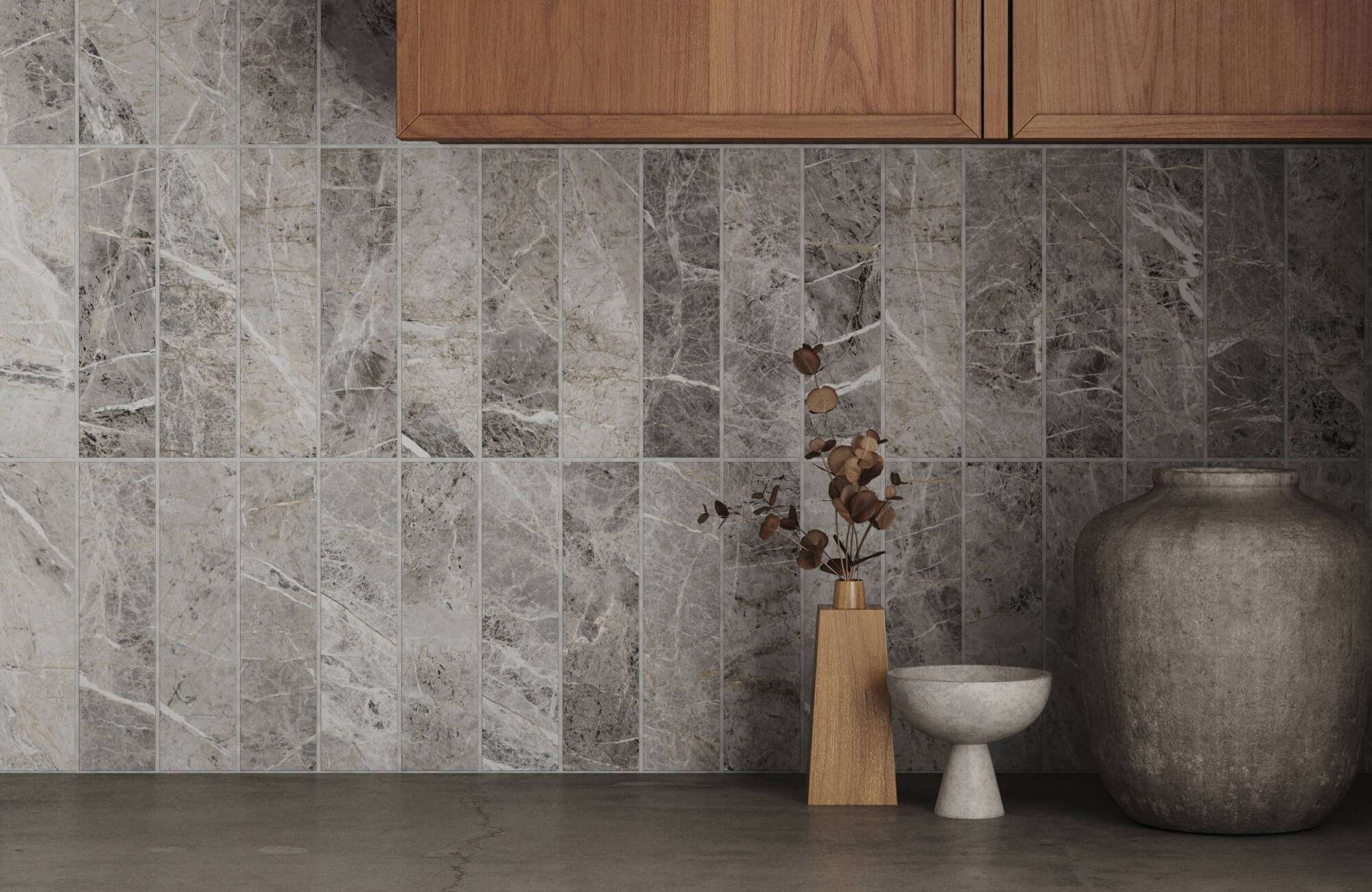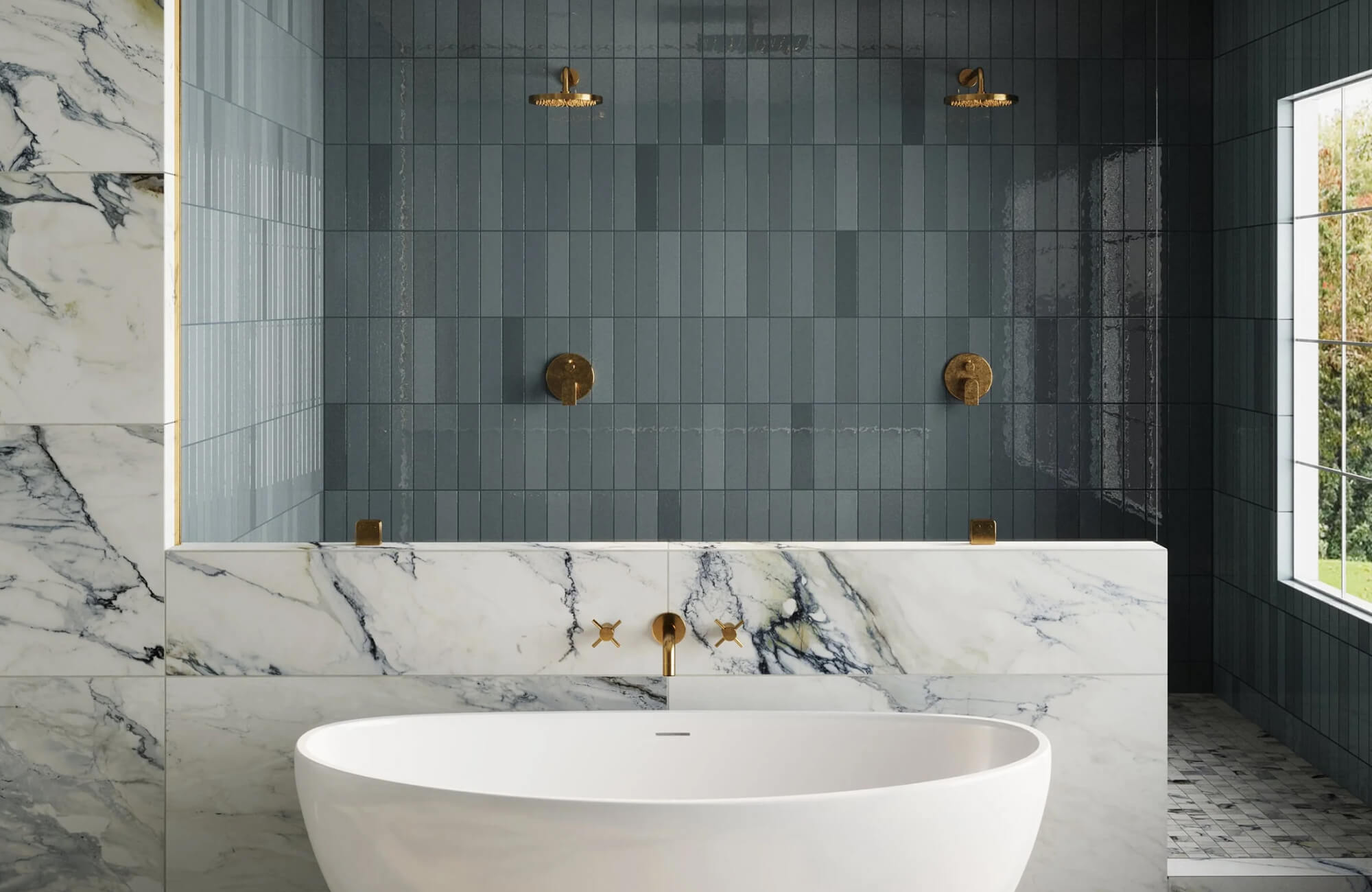Subway tile has come a long way since its debut in the early 20th century. You might still picture the classic white rectangles lining metro stations and minimalist kitchens, but subway tile has grown far beyond that image. Today, it’s a creative design element, available in an exciting mix of colors, textures, and materials.
In this article, we’ll take you through the evolution of subway tile, from its practical origins in the New York City subway system to the bold, versatile styles you can use in your home. What began as a symbol of cleanliness and order has become a way to express personality and style. Let’s explore how subway tiles can help you create a space that’s both functional and distinctly your own.

Subway Tile Origins
Before subway tile became a design staple in homes, it had a very different purpose and setting. Understanding why it was created and the choices behind its earliest designs gives you a whole new appreciation for its timeless appeal. This story sets the stage for how a humble tile became one of the most versatile tools in modern interior design.
Born in New York
It all began beneath the bustling streets of New York City in 1904, when the first subway stations introduced a groundbreaking tile design; glossy, rectangular, and radiant. These tiles weren’t selected purely for their appearance, they served a smart, functional purpose. Their smooth surface made cleaning simple, while the reflective finish helped brighten dimly lit underground spaces. Before long, their practicality and polished look caught the attention of architects and everyday users alike, who began incorporating this utilitarian charm into kitchens and bathrooms across a wide range of interiors.
Why White Was Chosen
White quickly became the natural choice, largely because it symbolized cleanliness, openness, and brightness, qualities that were especially valued in the early 20th century. Moreover, it complemented the limited artificial lighting available in both subway stations and residential interiors. Visually, white helped small, dim spaces feel larger and more welcoming, enhancing the overall sense of hygiene and clarity.
From a manufacturing standpoint, it was also a practical solution; white glaze was affordable, easy to produce in large quantities, and consistent in finish. As a result, the style gained popularity for its clean look and functional value. Although that practicality still holds, today's designs offer a wider and more expressive range of possibilities.

Exploring Tile Materials
As subway tile has evolved, so have the materials used to create it. Each one brings its character, durability, and design potential, giving you more ways than ever to personalize your space while meeting the demands of everyday life.
Ceramic Subway Tiles
Ceramic remains the cornerstone of subway tile design. It’s reliable, cost-effective, and a great choice if you’re just starting to explore tiling options. What truly sets ceramic apart is its versatility; you’ll find it in a wide range of finishes, sizes, and colors, all while preserving that classic, familiar appeal. Whether you’re updating a kitchen backsplash or refreshing a bathroom wall, ceramic subway tiles offer a durable, easy-to-clean surface that combines function with timeless style.
A great example is Edward Martin’s Jaden 2.5x16 Glossy Ceramic Tile in Eggshell, as displayed in the elegant bathroom photo above. Its elongated format modernizes the classic subway shape, while the glossy finish subtly reflects light, creating a bright, airy atmosphere. The soft eggshell hue also complements the natural wood cabinetry and gold accents, demonstrating how ceramic tile can deliver both sophistication and simplicity in a seamless, contemporary design.
Porcelain Subway Tiles
When your space demands a tougher surface, like flooring, mudrooms, or even outdoor patios, porcelain steps up as the more durable counterpart to ceramic. Because it’s fired at higher temperatures, porcelain becomes denser, non-porous, and significantly more water-resistant. In practical terms, this means greater resistance to cracking, staining, and moisture, making it a smart choice for busy and high-humidity areas such as showers and entryways. Additionally, modern manufacturing techniques allow porcelain to convincingly replicate the appearance of natural materials like stone and wood, giving you the freedom to create a sophisticated look with lasting durability.
Glass Subway Tiles
For a sleek, contemporary touch, glass subway tile offers a refreshingly modern edge. It introduces light, depth, and a radiant sheen that few other materials can match. In a sunlit kitchen, for instance, a wall of pale blue glass tiles can reflect daylight across countertops, creating a bright, airy feel that lasts into the evening. In a bathroom, glass tile behind a vanity can enhance ambient lighting and add a layer of elegance. These tiles are especially effective in making compact spaces feel more expansive. However, they require precise installation and tend to reveal smudges or fingerprints more easily, so a bit of extra care will help preserve their crisp, polished look.
Natural Stone Subway Tiles
If you're looking to bring a warm, grounded feel to your space, natural stone subway tiles deliver a level of character that’s hard to replicate. Each tile carries unique veining, texture, and natural variation, making every installation one-of-a-kind. Materials such as marble, travertine, and slate introduce depth and richness, adding visual and tactile appeal to your design. However, natural stone tends to be more porous and can be sensitive to acids or harsh cleaners, making it less ideal for areas with heavy moisture or frequent spills. It’s also generally more expensive, both in material cost and installation, so it’s important to factor that into your planning.

The Power of Color
Color can completely transform the mood and personality of a space, and subway tile is no exception. From subtle neutrals to vivid hues, the right shade can turn a simple surface into a striking design feature that reflects your style.
Timeless Neutrals
Neutrals like soft greys, warm creams, and gentle taupes are your go-to when you're aiming for a palette that feels both flexible and serene. These subtle shades ground a space without dominating it, allowing you to layer in bolder accents through cabinetry, countertops, or décor. Their adaptability makes them a natural fit for everything from classic kitchens to more contemporary layouts, ensuring they grow with your style over time.
Bold and Bright Shades
If you're looking to make a statement, bold and bright subway tiles offer an exciting way to infuse energy and personality into your space. Deep blues, forest greens, and even vibrant saffron yellows move far beyond the traditional white, introducing drama and a strong visual presence. These colors are especially impactful in spaces that thrive on creativity and movement, such as a lively kitchen or an inspiring home office. In addition to amplifying vibrancy, bold tiles can give you the freedom to express your style in a way that feels confident, modern, and uniquely yours.
A great example is Edward Martin’s Dani 1.6x5 Matte Ceramic Tile in Sage, as featured in the photo above. Its deep green hue creates a bold yet grounded atmosphere, while the slim format and vertical layout add visual height and rhythm to the space. Paired with contrasting grout, the tiles stand out even more, defining each line with clarity and intention. This installation shows how a bold tile choice can transform a utilitarian area into a visually compelling focal point, all without overpowering the rest of the room.
Earthy and Pastel Tones
Earthy and pastel tones bring a quiet charm that’s calming and approachable, making them ideal for spaces where you want a softer, more relaxed atmosphere. Shades like sage green, blush pink, sky blue, and terracotta offer just enough color to keep things interesting without overwhelming the room. These hues work particularly well in kitchens and bathrooms, where a sense of warmth and serenity is often desired. Additionally, their subtle nature makes them perfect for smaller spaces, providing visual interest while maintaining a light, airy feel.
Ombre and Gradient Styles
For a more unexpected and artistic twist, ombre and gradient subway tiles offer a striking way to bring movement and dimension into your design. Whether it’s a gradual fade from light to dark or a seamless transition across complementary hues, this style creates a sense of flow that draws the eye. It’s especially effective on larger wall surfaces, where the variation in tone adds visual rhythm without deviating from the classic rectangular tile format. With ombre tiles, you can also achieve a dynamic look that feels contemporary and cohesive.

Smart Design Tips
Choosing the right subway tile is only part of the equation; how you use it can make all the difference. With a few thoughtful strategies, you can bring out the best in your tile and create a space that feels balanced, intentional, and uniquely yours.
How to Choose Tile for Each Room
When selecting tile, function should always come first; different rooms have different needs, and the material you choose should rise to meet them. Ceramic and porcelain subway tiles are especially well-suited for most interior applications. Ceramic works beautifully in lower-moisture areas like powder rooms or backsplashes, where easy maintenance and aesthetic flexibility are key. Porcelain, with its dense, non-porous structure, is ideal for spaces that see frequent water exposure, such as bathroom floors, showers, or laundry rooms. It offers excellent durability and moisture resistance, making it a practical long-term choice.
In contrast, glass tiles, though striking in appearance, are best used on vertical surfaces in areas with less daily wear. However, they can be prone to chipping and tend to reveal smudges easily, so more frequent cleaning is required. Natural stone, on the other hand, adds warmth and organic texture, but its porous nature makes it more susceptible to staining and moisture absorption. Unless properly sealed and maintained, it’s better suited for drier, more gently used spaces. Choosing tile based on how a room functions also helps ensure your design is beautiful and built to last.
Coordinating Tile and Fixtures
Your tile doesn’t exist in isolation; it plays a vital role in tying together the room’s overall look, especially when it comes to fixtures and hardware. If you're using brushed brass or matte black faucets, consider pairing them with warm-toned tiles like creamy beige, soft taupe, or blush to create a rich, complementary contrast. On the contrary, chrome or stainless steel fixtures tend to work best with cooler shades like slate, soft grey, or icy blue, creating a more streamlined and modern effect. Always compare tile samples directly with your chosen finishes under the room’s natural and artificial light. This extra step ensures a cohesive palette and also helps prevent mismatches that could disrupt the design flow.
A perfect example of this thoughtful coordination is shown in the picture above, featuring Edward Martin’s Claire 3x12 Glossy Ceramic Tile in Eggshell. Its soft eggshell tones bring out the warmth in the brushed brass fixtures, while the glossy finish adds a subtle reflective quality that enhances the room’s lighting. Together, these elements demonstrate how a well-chosen subway tile and fixture pairing can create a seamless, polished, and inviting atmosphere.
Balancing Color and Material
Achieving a balanced look is essential when combining different design elements. If you’re working with a bold or colorful subway tile, it’s best to offset it with understated fixtures and neutral countertops to prevent the space from feeling overwhelming. Conversely, when your cabinetry or surfaces feature strong patterns or textures, a more subdued subway tile helps maintain visual clarity. Thoughtful contrast can also come from pairing different finishes, such as smooth glass with rugged stone, to introduce depth without creating clutter. As a final step, always take a moment to view the entire composition under various lighting conditions and from multiple angles. This ensures that your materials and colors work in harmony, creating a space that feels cohesive and intentional.
If you’re unsure where to start, our design services can help. Our tile experts will guide you through layout, materials, and color choices, making the process easier, more efficient, and tailored to your vision.

Creative Applications of Subway Tiles
Subway tile isn’t limited to kitchens and bathrooms, it’s a versatile design element that can elevate just about any space. With a little creativity, you can use it to add character, texture, and style throughout your home in both subtle and standout ways.
To help you explore these possibilities, Edward Martin’s augmented reality (AR) tool offers a convenient way to visualize how different tiles will look in your space before making any commitments. By uploading a photo of your room or using live view, you can test out colors, layouts, and tile sizes in your space. This hands-on approach makes it easier to make design decisions and ensures the final result aligns with your vision, whether you're designing a bold accent wall or a refined kitchen backsplash.
Kitchen Backsplashes
The kitchen backsplash is one of the best places to showcase the beauty and versatility of subway tile. While a classic horizontal layout always works, it’s also an opportunity to experiment with patterns like vertical stacking, herringbone, or offset designs. Since backsplashes typically cover a smaller area, they’re ideal for trying bold colors, glossy finishes, or textured surfaces without committing to a full-room statement. Deep navy, emerald green, or even a rich terracotta can create a striking focal point that energizes the space while still feeling contained. This also makes it easy to add visual interest and personality while keeping the overall look balanced and approachable.
One striking example is Edward Martin’s Catalina 2x16 Matte Porcelain Tile in Clay, as depicted in the photo above. Its warm terracotta tone brings an inviting, earthy quality to the space, while the elongated tile format and herringbone layout introduce a sense of movement and texture. The matte finish keeps the look grounded and sophisticated, perfectly complementing the natural wood tones and soft cream cabinetry for a design that feels both fresh and timeless.
Bathroom Walls and Floors
Subway tile is a functional and stylish choice for bathroom applications, offering remarkable versatility across walls and floors. On vertical surfaces, full-height tiling creates a polished, spa-like atmosphere, making it an excellent option for shower enclosures or bathtub surrounds. For a more classic or transitional look, tiling halfway up the wall adds subtle texture and visual structure without overwhelming the space, especially in powder rooms or smaller bathrooms.
When it comes to flooring, porcelain subway tile stands out for its strength and moisture resistance, making it well-suited for high-humidity environments. Smaller formats, such as our Natasha 2x6 Matte Porcelain Tile in Fog, are especially practical. Their compact size allows for easier fitting around fixtures like toilets and vanities while enhancing slip resistance, an essential feature for bathroom safety. With thoughtful placement and the right materials, subway tiles can also elevate the performance and appearance of any bathroom.
Showers and Tubs
In moisture-prone areas like showers and tub surrounds, tile selection plays a critical role in function and design. Materials such as glossy ceramic or porcelain are ideal, as they offer excellent water resistance and are easy to maintain. To enhance the overall look, grout choice can also make a noticeable difference. Contrasting grout lines can add definition and highlight the tile pattern, while matching grout creates a smooth, spa-like appearance. For added functionality and style, consider incorporating a recessed niche with a contrasting tile. It provides convenient storage and acts as a visual focal point that elevates the entire space.
Fireplace Surrounds
Subway tile extends far beyond kitchens and bathrooms; it can also be a striking addition to fireplace surrounds. When used around a hearth, it introduces texture and visual interest while still allowing the fireplace to remain the central focal point. For a cozy, dramatic effect, consider bold tones like glossy black or deep forest green to frame the firebox. Porcelain subway tiles are especially well-suited for this application, as they offer the heat resistance and durability needed for high-temperature areas. With the right color and layout, porcelain tile can transform a simple fireplace into a standout architectural feature.
Statement Accent Walls
Subway tiles can also make a powerful impression when used as an accent wall, adding depth and character to spaces well beyond kitchens and baths. Whether placed behind a bed, along a hallway, or as a backdrop in a dining room, it offers an opportunity to experiment with unexpected colors, unique shapes, or creative layouts. Accent walls are especially effective in open-plan homes, where defining separate zones visually, without the need for partitions, helps bring structure and style to the overall design. Additionally, with thoughtful placement and bold tile choices, a subway tile accent wall can serve as a functional element and a striking focal point.

Grout Makes a Difference
Grout may seem like a small detail, but it plays a major role in the overall look and longevity of your subway tile installation. From shaping the visual style to influencing maintenance needs, your grout choices can significantly enhance or detract from your finished space.
Blending or Contrasting
The grout color you choose can transform the look of your tile. If you want the tile to stand out, choose a contrasting grout color; it will define each piece and highlight the pattern. If you prefer a smoother, more uniform appearance, opt for grout that closely matches the tile. There’s no right or wrong choice, just the visual effect you're aiming to achieve.
A stunning example of contrast in action is Edward Martin’s Jaxson 4x21 Glossy Ceramic Tile in Pine, as displayed in the photo above. Its rich green tone is paired with a lighter grout, emphasizing the tall, vertical lines and creating a striking, architectural rhythm across the walls. This combination enhances the room’s sense of height while drawing attention to the tile’s elegant, elongated shape. It’s a clear reminder of how grout can be used as a design tool, not just a practical necessity.
Visual Impact on Space
Grout lines do more than hold subway tiles in place—they can subtly shape how a room feels and flows. Tighter grout lines in a shade that closely matches the tile can create a clean, seamless look, making the space feel more open and relaxed. On the other hand, wider grout lines in a contrasting color introduce visual rhythm and energy, naturally drawing the eye and emphasizing the subway tile layout. This approach is also especially effective for highlighting focal points or creating a sense of movement along extended surfaces like a backsplash or hallway wall. By adjusting grout width and color, you can influence how dynamic or serene a space appears.
Tips for Maintenance
While grout can require some upkeep, proper preparation makes maintenance straightforward and manageable. In areas exposed to moisture or heavy daily use, it’s essential to seal the grout to protect against water absorption and staining. For lighter grout shades, consider using stain-resistant formulations or keeping a grout pen nearby for easy touch-ups. If low-maintenance is a priority, darker grout tends to be more forgiving, helping to conceal everyday wear and buildup.
To get the best results, always refer to the manufacturer’s recommendations for both tile and grout. These guidelines are designed to suit the specific materials you’re working with, ensuring durability, ease of care, and long-lasting visual appeal.
Embracing New Subway Tile Colors
Subway tile is no longer confined to the crisp, white rectangles of its early days. It has evolved into a versatile design element that blends timeless appeal with modern expression. Whether you're drawn to soft pastels, bold hues, rich textures, or handcrafted finishes, there's a subway tile that reflects your style and meets your space’s needs. With so many colors, materials, and layouts to explore, your options are anything but limited. We're here to help you reimagine what subway tile can be and bring your vision to life with clarity and confidence.







